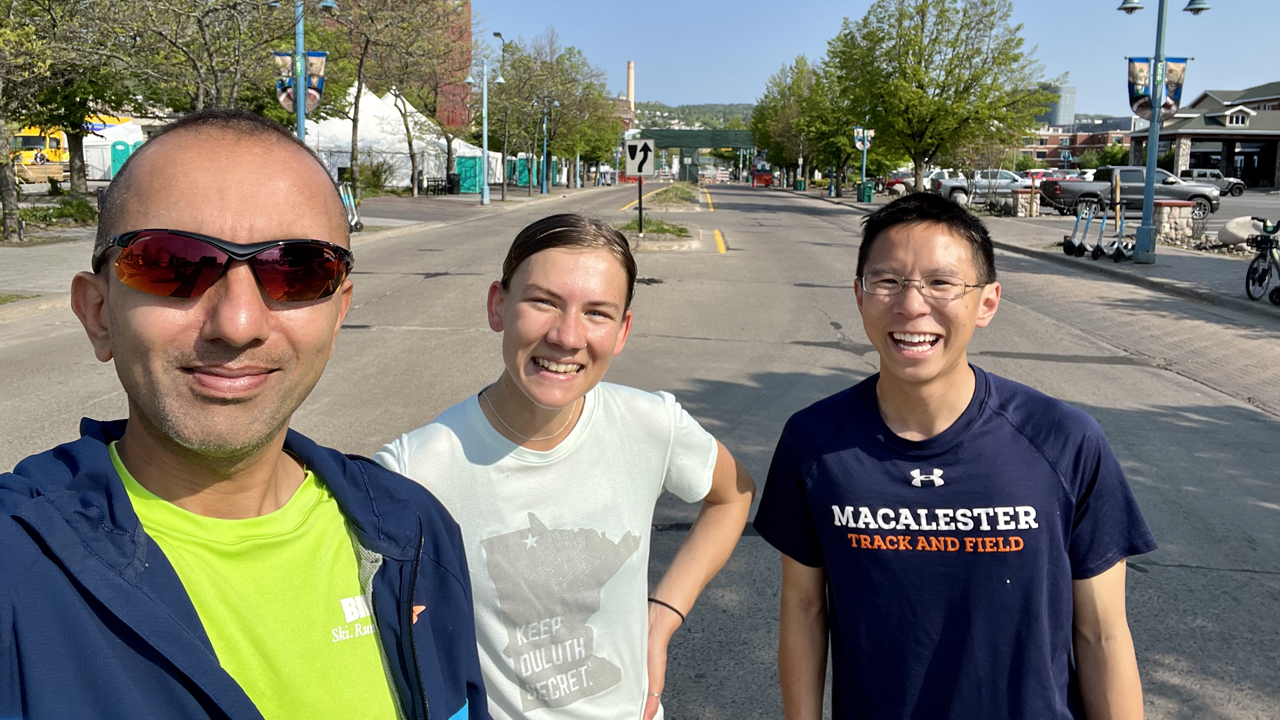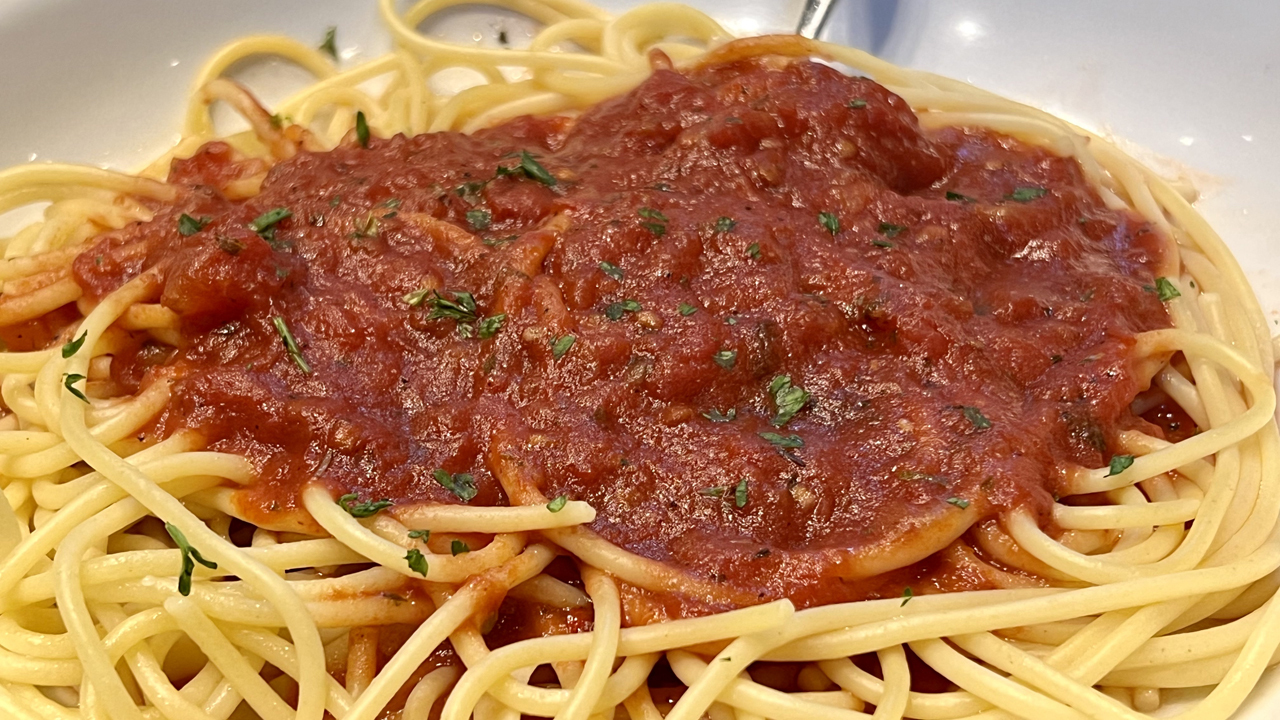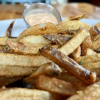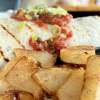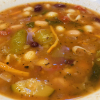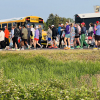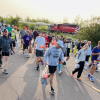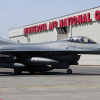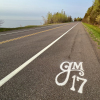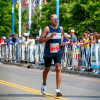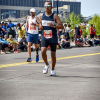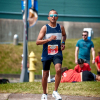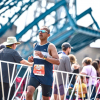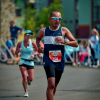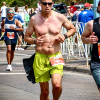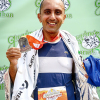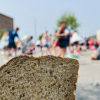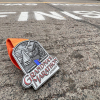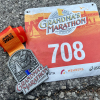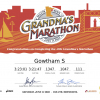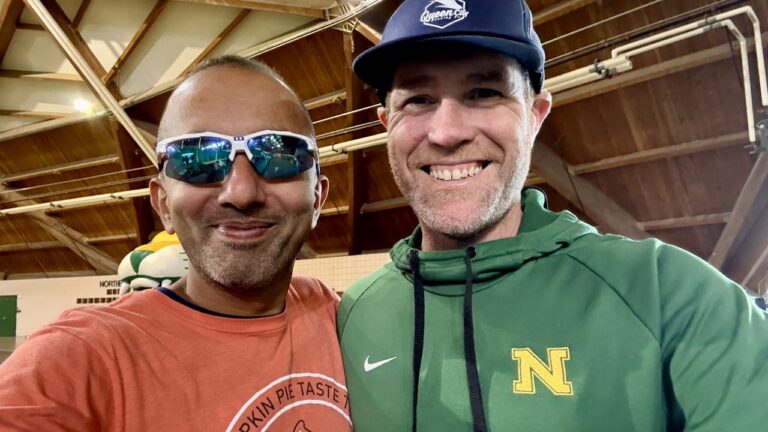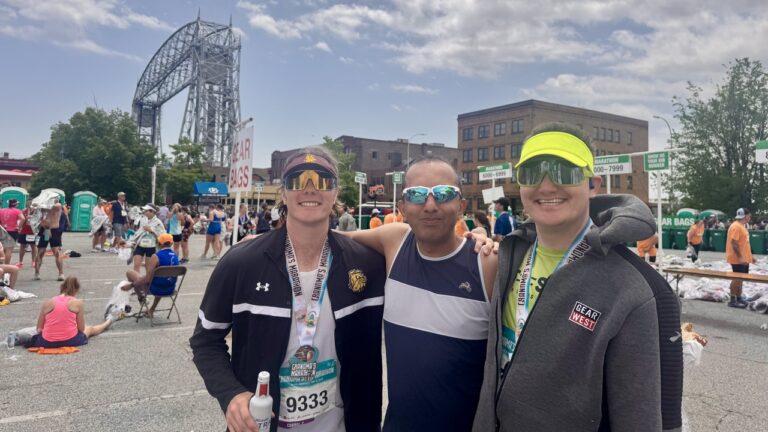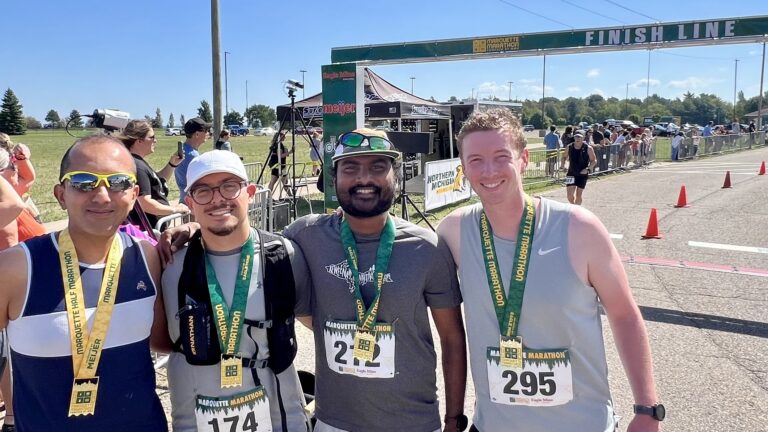It’s rarely ever a good sign when a healthy streak has fewer YESs than NOs. With three DNFs – 2021 Marquette Marathon, 2021 Milwaukee Lakefront Marathon and 2022 Marquette Marathon – in four tries (and far worse when DNSs were taken into consideration), such had become the nature of my streak of marathons in recent times. A review of my training log and discussions indicated few aspects that required some tweaking to race a marathon. Once I incorporated those tweaks, faith-ed very heavily in the fitness gained from cross country skiing as well as additional investments over the past eight weeks and left some room for cream, following a designated pace group with fellow runners felt gratefully smooth, strong and very much fun … earning me a new PR for this distance.
da Past Lessons
The training leading up to the 2022 Marquette Marathon – the freshest of the aforementioned DNFs – had been by far my most consistent effort. Analyzing its training log and summarizing the season-long learning from various formal and informal environments led me to implement some important changes to the structure of my training and the training log.
- The first major change was which activity types counted towards the training volume. I would still record all activities but the time and distance associated only with (a) biking, (b) cross country skiing, (c) hiking, (d) rollerskiing, (e) running, (f) strength training and (g) swimming - henceforth known as the trackable activities - would count towards my training volume. The rest would be catalogued as personal care. This was not my own idea but gleaned from the formal learning environments organized by the CXC, US Ski and Snowboard and USA Track and Field.
- The second major change was learning the value of rest, and it applied to both ends of the spectrum - not enough rest and a little too much rest. The not enough rest case was around the transition from cross country skiing to running OR in between marathon training blocks. The case of a little too much rest was during the taper period that used to make me stale going into the marathon weekend.
- The third major change was about the duration of marathon training cycles and choice of target marathons. With the former, I had so far used 16-week plans leading to a single event in early September. This approach wasn't leaving me enough time to rest, recoup and take another chance elsewhere before the cutoff date for a certain other marathon in April, if necessary. With the latter, I hadn't always picked an event that offered pace groups or hadn't made other arrangements (e.g., training with faster runners or partnering with them for a race, etc.) - leaving me to run much of these events solo.
- The fourth major change was learning to trust the training and have faith on race day. Learning to translate/transfer that trust from academic to athletic endeavors wasn't done on my own. Several of my friends, mentors and elite as well as professional athletes had been far too kind in sharing their own practices over the past several months in answering my questions: How do you gain trust in your training? What gives you confidence/belief that what you have done will be enough to do what you need to do on race day? What, if any, do you think on race day - during the race and especially when things get difficult? A collective summary of their responses boiled down to adding few more fields/columns in my training log for each trackable activity: What were the aims and expectations?, What did I do well? and What could have I done better? Application thereof entailed consciously believing in the aims/expectations of each activity, making an effort to move an item or two from the What could have I done better? list to the What did I do well? list over a reasonable length of time and giving myself grace when I regressed on occasion.
- The fifth major change was about the diversification of running portfolio. While cross country skiing and running had been taking respective seasonal priority, running hadn't enjoyed the same diverse range of racing distances as cross country skiing in recent times. There was enough variety in terms of surfaces (e.g., road, dirt, trail, track, etc.) and paces/efforts (e.g., easy, slow, recovery, hills, fast, fun, sexy, etc.) but the eventual focus was still on the road marathon. I hadn't made getting better at other distances (e.g., 1M, 5k, 10k, 13.1M, etc.) a conscious effort. In turn, I had been missing out on the benefits of a symbiotic relationship between those other distances and road marathons.
As with the fifth and final one, I planned on taking up on the opportunities to race any of these distances if they surfaced along the way and then set aside short but dedicated phases to get better at them. The fourth item had been in practice for quite some time. Putting the first three observations/learning into practice …
- I wrapped up my 2022-23 cross country skiing season – my best and the most fun one yet – around Easter Sunday and took a 10-day break to let the body and mind recover.
- I opted for two rather aggressive 8-week plans with about a 10-day taper – one for Summer and one for early Autumn with a reasonable amount of rest in between.
- Choosing Grandma’s Marathon as the target for the first 8-week training plan in Summer was a fairly easy and straightforward decision: I had run it before and I was familiar with the course (specifically, I knew exactly where things had started going wrong and crying had begun in 2019) and the event provided necessary pace groups.
da Training Plan
There were a few drafts (or iterations) before I picked one that would work for me. One of the drafts included a variant of a 16-week plan published by Runner’s World. I shelved it since it would have started very shortly after the 2023 American Birkebeiner cutting my cross country ski season short. I ended up using a 8-week plan from Women’s Running. It was conservative in its as is form and with input/feedback from the family, I made some changes to expand my comfort zone.
- Keeping its conservative nature in the early days to ensure the body got used to the impact of running without inviting an unnecessary injury.
- Simplifying it in some aspects to avoid decision fatigue, and crafting task-specific workouts.
- Incorporating strength sessions and strides, and a shorter taper towards the end.
For the purposes of this event and its training, a microcycle represented a period of seven days (one calendar week starting on Monday), and a phase represented a non-trivial amount of time dedicated towards a certain aspect. It might have been an overkill to superpose a layer of block periodization on top of what was already a quite short training block. So, a sensible and functional overloading (Functional Overreaching in Endurance Athletes: A Necessity or Cause for Concern? Sports Medicine, vol. 50, p. 1059, 2020 – via Megan and David Roche’s Some Work All Play podcast) was my guiding concept for these eight weeks: starting slow, adding volume and then intensity, consuming sufficient (and hearty) nutrition and moving activities around a little to accommodate better recovery … prior to the 7-10 day taper and race day.
A pleasant outcome of the recon mission-isque trip to Duluth in week #04 was getting to see Jason Cork (JC). The last time I had seen him in flesh and blood was about a decade and half ago – back when I didn’t believe in endurance sports at all and sincerely believed that something had to be terribly wrong to make someone run (or bike or ski or whatever) unfathomably obnoxious lengths (of time). Over the course dinner with a beverage and half, amongst other topics of mutual relevance, JC brought up a book he had been reading – Infinite Powers by Dr. Steven Strogatz. Needless to say, the book immediately had me by its title. Within the next 24 hours, while there were some dry portions as well as some topics I had long been familiar with (e.g., converting a circle to a rectangle – thanks to Dr. Alex Kostinski in the early days of my graduate school at Michigan Tech, circle as a limiting case of a regular polygon, etc.), the book had me by several beautiful lullabies like this one:
There is something so paradoxical about . On the one hand, it represents order as embodied by the shape of a circle – long held to be a symbol of perfection and eternity. On the other hand,
is unruly, disheveled in appearance, its digits obeying no obvious rule or at least none that we can perceive.
is elusive and mysterious forever beyond reach. Its mix of order and disorder is what makes it so bewitching.
Wondering what a book about Calculus got to do with running marathons or distance/endurance events at all? Glad you asked. I had known about the concept of chunking: the value of little and seemingly insignificant but incremental and consistent work that helps build bigger things down the road. I have even been practicing it – consciously or unconsciously – in various (mostly academic) endeavors, and implemented it as an expectation in the courses I teach at Michigan Tech for several years now.
In athletics, however, the farthest I got to applying chunking was following a training plan … mostly as prescribed and not attempting 450 miles or 85 hours of training the night before the marathon. To be specific, I hadn’t gotten around to understanding (let alone practicing) how chunking applied to any given run. To be even more specific, I hadn’t figured out how to implement the chunking the total and remaining distance, and focusing on the current chunk goal in training or in races.
All that changed partway through this (audio)book. I am sure JC (and every coach/teacher for that matter) can relate to teaching the same something to someone 50 different ways and then a slightly different 51st way that someone else teaches makes that something make sense and stick. I had my own share of trying to learn and being preached to chunk the total and remaining distance, and focusing on the current chunk via run the mile you are in or any number of such equivalent phrases.
Though this book, Infinite Powers, made no mention of running or athletics, it was that symbolic 51st way that an easily implementable approach to chunking became apparent to me – running the marathon (or any distance for that matter; extendable to training plans of any length or a series of them) as an application of Differential and Integral Calculus. With the don’t try anything new on race day principle still in effect, I practiced this Calculus during the final two long runs (20-miler with 4 x 5-mile chunks in week #06 and 12-miler with 4 x 5k chunks in week #07) and several other workouts.
Why not as many chunks as the number of miles? Glad you asked again. As I interpreted it, this was an optimization problem too: too many chunks and then I’d be doing Math so frequently that I might not have any time to scan the body and surroundings; too few chunks and then I might be so lost in scanning the body and surroundings that I’d forget to do the Math. Plus, I didn’t believe I had matured enough yet to get each mile split (by pace or effort) consistently close enough. However, I had gained some experience doing so for 5k or 5-mile chunks in training runs – leaving me enough room within that 5k/5-mile segment to respect the terrain/weather and learn to ration the resources. Plus, when running by myself, it was a lot easier to keep track of just four-five numbers (usually, time taken to traverse a given 5k/5-mile segment and always rounded to the nearest integer to get a back of the envelope estimate and avoid unnecessary mental taxation), do some Math once in a while, and use the remaining distance/time to scan and get a better feel for the body and the surroundings.
The table below provides a quick little numerical summary of the trackable activities I completed. The beautiful orange-yellow button below that table provides a relatively grander summary of the planned schedule, my compliance with it, some notes I made along the way and a lot of interactive eye candies. If interested in granular details of one or more of them, kindly check out my Strava profile.
Overall Summary2023-04-24 - 2023-06-18Time in h:mm:ss, distance in miles (and kilometers) and elevation gain in feet (and meters) |
|||||
|---|---|---|---|---|---|
| # | Activity Class and Type | Count | Duration | Distance | Elevation |
| 1 | Bike | 3 | 1:53:54 | 27.34 (44.02) | 40 (12) |
| 2 | Hike | 1 | 2:07:07 | 6.22 (10.01) | 479 (146) |
| 3 | Rollerski (Skate) | 1 | 0:57:17 | 6.36 (10.24) | 164 (50) |
| 4 | Run | 66 | 68:52:48 | 415.43 (668.84) | 9773 (2979) |
| 5 | Strength | 20 | 10:58:14 | - | - |
| Training Activities | 91 | 84:49:20 | 455.35 (733.11) | 10456 (3187) | |
da Race Weekend
The pacing plan for this event was fairly straightforward: follow the pacer and fellow racers in that group. The choice of 3:20 as the target time was derived after objectively analyzing my performances in various workouts, long runs and events over the past eight weeks (and some belief that I’d pull it off if I ensured my brain/mind remained an asset and not a liability on race day). Based on what Geeta 2:47 had been preaching since I was a child (by far the most difficult thing to implement or implement consistently) and what I had practiced during the 2023 American Birkebeiner as well as during training runs over the past four weeks, I expected the following items – individually or collectively – to help me during this marathon:
- Keeping the goal in mind but staying detached from the result.
- Remembering THE WHY and that 26.2 miles will be my happy place (so, smiling A LOT) on race day.
- Chunking the total and remaining distance, and focusing on the current chunk.
2019 had taught that driving in/around Duluth and finding a parking spot at the expo could drain a lot of mental energy. So, I had opted to receive my bib in the mail ahead of time and didn’t need to visit the expo. When the news came around that Kara Goucher would be at the expo, that plan of not needing to visit the expo changed. Instead of leaving Houghton very early on Friday (like 5 am), I left on Thursday evening (like 5 pm) to avoid car legs and potentially longer lines/wait times to meet Kara.
After a full night of sleep and a pleasant run on Friday morning in Superior (Wisconsin), the rest of the drive to The Land of 10,000 Lakes was quick, smooth and uneventful. Getting to DECC well before the expo started was a good idea: finding parking spot was a breeze and I got to explore the finish area (got to meet Hanna and Sam) before getting in line to meet Kara. I was 4th or 5th in line from the front, and it was only about a 50-minute wait. She showed up ahead of time, was kind enough to sign a copy of her book, The Longest Race, and stand for a photo with me (courtesy of one of my fellow linemates).
The recon mission-isque trip to Duluth a month ago had shown me where the hotel was and where I could get quality nutrition without longer wait lines/times. I checked into the hotel after a quick stop at one of those nutritional sources – At Sara’s Table (thanks Brooke!) – for lunch. After settling down in the hotel and getting some rest, I made a quick trip to another of those nutritional sources – Whole Food Co-op – to acquire some more supplies for the weekend including to go pre- and post-race meals. After some more resting, the dinner at Olive Garden was surprisingly very fast (with an exceptional Minnesota nice kinda service) … even on the eve of a BIG marathon – about 35 minutes including 10 minutes of driving! After carefully laying out everything I’d need for the next day, I was in bed by 7:00 pm local time.
Though early, around 3:30 – 4:00 am, the race day morning came at a very relaxed pace after a really good night of sleep. I knew from 2019 that attempting to get into the DECC for parking would be a colossal waste of time. A kind and gracious Duluth Police Officer got out of his vehicle, moved the barricade, let me park on a side street and offered to keep an eye on it while I ran! Walk-Jogging down to the DECC was a breeze and so was getting in line to board the North Shore Scenic Railroad train to Two Harbors. Unlike in 2019, there was a considerably looonger line to board the train at 5 am! But I got a seat and on the correct side that offered spectacular views of Lake Superior. Ala train rides while growing up on the other side of the planet, this one too was a very communal experience.
The train didn’t get there soon enough to leave me enough room for a W/U jog. It wasn’t train’s fault but something I will need to keep in mind for the next time. There was however plenty of time to wrap up the final preparations, drop the bag and find my way to the chosen pace group location. After a brief chat with the 3:20 pace group leader (Jackie), I did some mobility and activation drills in place before the area got crowded. Just a couple seconds or so after the O’er the land of the free and the home of the brave, a couple of F-16s from the 148th Fighter Wing (Minnesota Air National Guard) of the US Air Force flew over!
I won’t lie – in spite of having objectively arrived at the 3:20 target time/pace group decision, there was some internal debate over the final few minutes before the start: Can I actually hold this pace all the way?, Maybe I overestimated my training and I should move back to the 3:30 group?, Maybe I underestimated my training and I should move up to the 3:10 group?, and so on. As the closing minutes ticked by, I decided to have faith in the ysis part of my objective analysis, pacer’s ability to lead, my ability to follow her, and stayed in her group.
There was yet another research paper/study (A Trade-Off Between Cognitive and Physical Performance, With Relative Preservation of Brain Function, Scientific Reports, vol. 7, #13709, 2017) that served as the 51st way of getting the keep your mind calm or don’t overthink it advice home – which I found from a book during the taper period … which I learned about via Chris Evert‘s commentary during the 2023 French Open Final … which I would not have watched had it not been for a nudge to watch Track and Field events by John … who had in fact been one of the several folks trying to get that very point into my head via 50 different methods so far.
Once we got moving, the 3:20 pace – amidst some trepidation – felt comfortable enough. The first 4-5 miles were with Craig Ikens (#2987) – we kept each other company and stayed about 20-30 feet behind the pace group leader. I can’t speak for him but I did not realize that Jackie (pace group leader) was GAPing (i.e., gradient/grade adjusted pacing) taking into account the subtle variations in the course profile until Jeff Nyquist mentioned it a few miles later. Running along and conversing with Jeff made the miles go by effortlessly. I ran on both sides of the road to avoid camber-induced foot pain, followed his lead when taking tangents, and looked for shade when the predicted/expected cloud cover was a no show.
I vividly remember echoing Jeff’s sentiments – that 7:35-7:40 min/mile pace through 10-12 miles felt like we were holding back a LOT. Based on my process-goal for the event and Jeff’s hint that temperature was on the rise, I let go of any thoughts to push the pace too soon and kept (re-)assessing the situation at 15, 20 and 23 mile markers – each time deciding to stay with the pace group. Crossing the 18th mile without any physical pain was a big confidence boost (things had started falling apart here in 2019) and climbing the Lemon Drop Hill with what seemed like relative ease around mile 22 was an even bigger confidence boost (I had literally started crying here in 2019 – mostly in embarrassment).
Having run 38, 38, 38, 38 and 39 minutes (rounded to the nearest integer) for each of the first five 5-mile chunks, I upped my effort the rest of the way but it did not result in any increased pace. When I crossed the finish line, the clock showed something in the neighborhood of 3:21 … approaching 3:22. The first order of business was to stop the Garmin and save the run, and the next item in line was to kneel down and kiss the ground. A kind lady then escorted me to the announcers’ booth – to have a quick chat with Peter Graves who graciously made time to catch up amidst his super busy schedule.
I eventually made my way to the post-race hangout area – collected my medal, had a few photographs taken by the event photographers, picked up the drop bag (rookie mistake/oversight error – not packing dry clothes and sandals) and found yummy food (some that I carried and rest provided with grandmotherly care by the volunteers). The official finish time turned out to be 3:21:47 – good for 1349/6690 overall, 1047/3933 in gender and 111/440 in AG.
Process-, Event- and Time-Based GoalsListed in order of importanceEvent-based is used in place of Performance-based AND Time-based is used in place of Outcome-based to clarify the listing |
||
|---|---|---|
| # | Description | Status |
| P1 | Train consistently, listen better, improve running by feel, make adjustments and toe the start line sufficiently rested | Yes |
| P2 | Start with a pace group, release the excitement in a sensible fashion, stay with the group through 15-20-23-25 miles, take meaningful chances and cross the finish line with a smile | Yes |
| T1 |
Finish below 3:46:16
(8:38 min/mile, 6.95 mph ≡ 5:21 min/km, 11.18 kmph)
Improve upon the event PR from 2019 Grandma's Marathon |
Yes |
| T2 |
Finish below 3:27:44
(7:55 min/mile, 7.58 mph ≡ 4:55 min/km, 12.20 kmph)
Improve upon the PR from 2020 Holland Haven Marathon |
Yes |
| T3 | Finish below 3:19:59 (7:38 min/mile, 7.86 mph ≡ 4:44 min/km, 12.70 kmph) | No |
Evolution of race day reality (3:21:39) with respect to time-based goal (3:19:59 ≡ 7:37 min/mi)Time in h:mm:ss, distance in miles, elevation gain/loss in feet and pace in min/miTime of the day and weather - temperature/feels like/dew point (F), wind speed (mph), humidity (%) and sky/precipitation |
|||||||
|---|---|---|---|---|---|---|---|
| # | Lap Distance |
Lap Pace |
Lap Elevation |
Total Time |
Total Pace |
ΔTime | Local Time and Weather Conditions |
| 01 | 1.00 | 7:37 | 26↑ 23↓ | 0:07:37 | 7:37 | 0:00:17 | 7:46 - 57/56/53 F, 0 mph N, 88%, clear sky |
| 02 | 1.00 | 7:39 | 20↑ 46↓ | 0:15:16 | 7:38 | 0:00:10 | 7:53 - 54/54/51 F, 0 mph N, 88%, few clouds |
| 03 | 1.00 | 7:37 | 13↑ 43↓ | 0:22:53 | 7:37 | 0:00:17 | 8:01 - 55/54/51 F, 0 mph N, 88%, few clouds |
| 04 | 1.00 | 7:39 | 10↑ 10↓ | 0:30:32 | 7:37 | 0:00:17 | 8:09 - 56/55/52 F, 0 mph N, 87%, few clouds |
| 05 | 1.00 | 7:39 | 3↑ 23↓ | 0:38:11 | 7:38 | 0:00:10 | 8:16 - 62/62/55 F, 0 mph N, 78%, clear sky |
| 06 | 1.00 | 7:36 | 36↑ 43↓ | 0:45:47 | 7:37 | 0:00:17 | 8:24 - 58/57/52 F, 1 mph E, 82%, clear sky |
| 07 | 1.00 | 7:39 | 16↑ 7↓ | 0:53:26 | 7:37 | 0:00:17 | 8:32 - 59/58/52 F, 1 mph SE, 80%, clear sky |
| 08 | 1.00 | 7:37 | 36↑ 10↓ | 1:01:04 | 7:38 | 0:00:10 | 8:39 - 59/58/52 F, 1 mph SE, 80%, clear sky |
| 09 | 1.00 | 7:37 | 30↑ 10↓ | 1:08:42 | 7:38 | 0:00:10 | 8:47 - 58/58/52 F, 1 mph SE, 80%, clear sky |
| 10 | 1.00 | 7:28 | 0↑ 69↓ | 1:16:11 | 7:37 | 0:00:17 | 8:55 - 58/57/52 F, 1 mph E, 81%, clear sky |
| 11 | 1.00 | 7:42 | 30↑ 3↓ | 1:23:53 | 7:37 | 0:00:17 | 9:02 - 62/61/48 F, 1 mph SE, 60%, clear sky |
| 12 | 1.00 | 7:40 | 26↑ 36↓ | 1:31:34 | 7:37 | 0:00:17 | 9:10 - 59/58/51 F, 2 mph SE, 76%, clear sky |
| 13 | 1.00 | 7:31 | 3↑ 10↓ | 1:39:06 | 7:37 | 0:00:17 | 9:17 - 59/58/51 F, 2 mph SE, 76%, clear sky |
| 14 | 1.00 | 7:28 | 10↑ 10↓ | 1:46:35 | 7:36 | 0:00:43 | 9:25 - 59/58/51 F, 2 mph SE, 74%, clear sky |
| 15 | 1.00 | 7:31 | 23↑ 10↓ | 1:54:06 | 7:36 | 0:00:43 | 9:32 - 63/62/47 F, 3 mph SE, 57%, few clouds |
| 16 | 1.00 | 7:33 | 13↑ 26↓ | 2:01:39 | 7:36 | 0:00:43 | 9:40 - 63/61/47 F, 3 mph E, 56%, few clouds |
| 17 | 1.00 | 7:37 | 23↑ 7↓ | 2:09:16 | 7:36 | 0:00:43 | 9:48 - 63/62/53 F, 5 mph NE, 69%, clear sky |
| 18 | 1.00 | 7:33 | 20↑ 7↓ | 2:16:49 | 7:36 | 0:00:43 | 9:55 - 63/62/52 F, 5 mph NE, 68%, clear sky |
| 19 | 1.00 | 7:28 | 7↑ 36↓ | 2:24:17 | 7:35 | 0:01:10 | 10:03 - 64/63/53 F, 3 mph SE, 68%, clear sky |
| 20 | 1.00 | 7:40 | 30↑ 0↓ | 2:31:57 | 7:35 | 0:01:10 | 10:10 - 64/64/53 F, 3 mph SE, 66%, clear sky |
| 21 | 1.00 | 7:40 | 36↑ 16↓ | 2:39:38 | 7:36 | 0:00:43 | 10:18 - 65/64/53 F, 2 mph E, 65%, clear sky |
| 22 | 1.00 | 7:37 | 7↑ 26↓ | 2:47:16 | 7:36 | 0:00:43 | 10:26 - 66/65/53 F, 3 mph NE, 63%, clear sky |
| 23 | 1.00 | 7:51 | 52↑ 33↓ | 2:55:07 | 7:36 | 0:00:43 | 10:33 - 66/65/53 F, 3 mph NE, 63%, clear sky |
| 24 | 1.00 | 7:43 | 16↑ 30↓ | 3:02:50 | 7:37 | 0:00:17 | 10:41 - 66/65/53 F, 3 mph NE, 63%, clear sky |
| 25 | 1.00 | 7:42 | 10↑ 26↓ | 3:10:32 | 7:37 | 0:00:17 | 10:49 - 66/66/53 F, 3 mph SE, 62%, clear sky |
| 26 | 1.00 | 8:19 | 16↑ 43↓ | 3:18:52 | 7:38 | 0:00:10 | 10:56 - 66/65/53 F, 3 mph S, 65%, clear sky |
| 27 | 0.35 | 7:56 | 3↑ 3↓ | 3:21:39 | 7:39 | 0:00:35 | 11:05 - 66/65/53 F, 5 mph NE, 64%, clear sky |
| The final cumulative time, 3:21:39, may not match the official time (3:21:47.0) owing to rounding errors. Starting my watch a few seconds before the start and stopping it a few seconds after crossing the finish line can be an additional reason for this discrepancy. The overall distance, 26.35 miles, may not match the designated (or certified) event distance (26.22 miles) owing to idiosyncrasies associated with GPS data collection OR my inability to take the tangents OR the aforementioned early start/late stop reasons, and in some rare cases, incorrectly measured (or advertised) courses or DNFs. As a result, the cumulative pace and the projected finish time may deviate from reality. | |||||||
The long walk to the car was punctuated with many stops to cheer on the fellow runners and meeting the ever so gracious Obsie Birru (she had finished the marathon in 2:39-ish and looked daisy fresh!) in Starbucks. As he had offered several hours earlier, the same Duluth Police Department Officer had been guarding the area (part of the race course and part of the side street) and keeping an eye on several racers’ cars, and he was kind enough yet again to move the barricades to let me get out without a hassle!
da Takeaways
I knew eights weeks is about half as long as 16 weeks but they seemed to have flown by in a hurry. Because of this brevity, there was a heightened emphasis to design/choose a training plan, and staying on track with supplemental habits (e.g., consistent strength training) felt relatively easier. In spite of this brevity, there was still some room for cream – to try different/new things which weren’t necessarily part of the plan.
Participating in the #RunStreak put together by my colleagues at work (from the 1st of May through 4th of June – run/walk at least one continuous mile each day) was one of them – forcing me (in a good way) to keep the easy/recovery runs at the necessary effort level, evaluate rest and recovery between runs of harder effort, and learn to run by feel. Completing a double tempo/threshold workout (Does Lactate-Guided Threshold Interval Training within a High-Volume Low-Intensity Approach Represent the “Next Step” in the Evolution of Distance Running Training? International Journal of Environmental Research and Public Health, vol. 20, p. 3782, 2023 – developed by Marius Bakken and popularized by the Ingebrigtsen family) on accident in week #06, figuring out its implementation for my desired distance via some trial and error, and making it a regular staple of my weekly routine was another. I had never been a fan of #RunStreak before and I had believed a double tempo/threshold workout (and its two and two can make five kinda beautiful Math) was a few seasons away.
All said and done, I am quite proud of the progress I made on various fronts during this training block: (a) taking a conscious break after the cross country ski season, (b) starting the running season slowly, building volume, adding and then mixing intensity, (c) building speed without haste, (d) using the training plan as a general guide and moving activities within any given week to accommodate better recovery, (e) picking up supplemental habits (e.g., incorporating strength work albeit mostly body weight related), (f) learning to read my body better and in turn, running more by feel than purely by hard metrics, (g) Calculus-ing the runs, (h) learning to translate trust the process from academic adventures to athletic endeavors and (i) transitioning towards time-based training plans (and in turn, getting a much better idea about designing an annual training plan).
I do believe the transition to speed/intensity might have earlier, easier and smoother had I run and strength trained more consistently throughout Winter. The official time might have been 3:19-ish instead of 3:21-ish had I run faster over the final 1.25-1.50 miles. It is possible that another gel around mile 23 or 24 would have provided me with the necessary energy to generate the desired pace. While it seemed like I pushed as hard as possible at that time, it is also quite possible that … knowing the 2024 BQ standard (sub-3:10) wasn’t achievable, I might have been sub/unconsciously content/complacent with a certain (as in guaranteed) PR and in turn, might not have dug deep enough.
Be that all as they may, I was/am satisfied with various other aspects of this run – specifically, running end to end, running with a relatively calm mind and running very consistent and smooth 5k/5-mile chunks: the individual splits through mile 25 seem metronomic and the negligible variance in the average pace (just 3 seconds over the course of the marathon) seems like someone else ran this race! It’s time for a short break highlighted by checking off my bucket list entities spread around the lovely state of Minnesota and then sprinkled with some unstructured activities before picking the process back up for the next event.
Thanks be to
the rejections and opportunities life has brought my way, event folks (organizers, sponsors, volunteers, timers, law enforcement officials, photographers, fellow participants and spectators) and my family of good friends, mentors and coaches in and outside of my community for all the unexpected, undeserved and unrewarded acts of kindness and constant encouragement as well as offerings of constructive criticism to improve myself as a human and an athlete. I am eternally grateful to all those who let me train with them, who shared their meals and experiences with me, who helped keep me in good health, who helped me stay the course, and who cheered me on from home or along the course.
